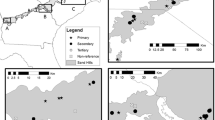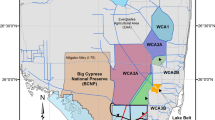Abstract
Geographic Information System (GIS) was used to identify potential reference sites for wadeable stream monitoring, and multivariate analyses were applied to test whether invertebrate communities reflected a priori spatial and stream type classifications. We identified potential reference sites in segments with unmodified vegetation cover adjacent to the stream and in >85% of the upstream catchment. We then used various landcover, amenity and environmental impact databases to eliminate sites that had potential anthropogenic influences upstream and that fell into a range of access classes. Each site identified by this process was coded by four dominant stream classes and seven zones, and 119 candidate sites were randomly selected for follow-up assessment. This process yielded 16 sites conforming to reference site criteria using a conditional-probabilistic design, and these were augmented by an additional 14 existing or special interest reference sites. Non-metric multidimensional scaling (NMS) analysis of percent abundance invertebrate data indicated significant differences in community composition among some of the zones and stream classes identified a priori providing qualified support for this framework in reference site selection. NMS analysis of a range standardised condition and diversity metrics derived from the invertebrate data indicated a core set of 26 closely related sites, and four outliers that were considered atypical of reference site conditions and subsequently dropped from the network. Use of GIS linked to stream typology, available spatial databases and aerial photography greatly enhanced the objectivity and efficiency of reference site selection. The multi-metric ordination approach reduced variability among stream types and bias associated with non-random site selection, and provided an effective way to identify representative reference sites.
Similar content being viewed by others
References
Barbour, M.T., Plafkin, J.L., Bradley, B.P., Graves, C.G., & Wissman, R.W. (1992). Evaluation of EPA's rapid bioassessment benthic metrics: metric redundancy and variability among reference stream sites. Environmental Toxicology and Chemistry, 11, 437–449.
Barbour, M.T., Gerritsen, J., Snyder, B.D., & Stribling, J.B. (1999). Rapid bioassessment protocols for use in streams and wadeable rivers: Periphyton, benthic macroinvertebrates and fish. Second edition, EPA 841-B-99-002, Washington D.C: U.S. Environmental Protection Agency, Office of Water.
Biggs, B.J.F., & Kilroy, C. (2000). Stream Periphyton monitoring manual. Wellington: Published by National Institute of Water and Atmospheric Research for the New Zealand Ministry for the Environment, pp. 228. (http:// www.smf.govt.nz/results/5092_periphytonmanual.pdf).
Boothroyd, I., & Stark, J. (2000). Use of invertebrates in monitoring. New Zealand stream invertebrates: ecology and implications for management. In Collier, K. J. & Winterbourn, M. J. (eds.), pp. 344–373, Christchurch: New Zealand Limnological Society.
Boothroyd, I.K.G., Harding, J.S., & Death, R.G. (2002). Guide to the selection of reference sites for environmental monitoring of New Zealand rivers and streams. Wellington: New Zealand Macroinvertebrate Working Group report no. 2, Ministry for the Environment.
Chessman, B.C., & Royal, M.J. (2004). Bioassessment without reference sites: use of environmental filters to predict natural assemblages of river macroinvertebrates. Journal of the North American Benthological Society, 23, 599–615.
Clarke, K.R., & Gorley, R.N. (2001). Primer v5: User manual/tutorial. U.K: Primer E, Plymouth.
Clarke, R.T., Furse, M.T., Gunn, R.J.M., Winder, J.M., & Wright, J.F. (2002). Sampling variation in macroinvertebrate data and implications for river water quality indices. Freshwater Biology, 47, 1735–1751.
Collier, K.J., & Halliday, J.N. (2000). Macroinvertebrate-wood associations during decay of plantation pine in New Zealand pumice-bed streams: stable habitat or trophic subsidy? Journal of the North American Benthological Society, 19, 94–111.
Collier, K., & Kelly, J. (2005). Regional Guidelines for Ecological Assessments of Freshwater Environments. Macroinvertebrate Sampling in Wadeable Streams. Environment Waikato Technical Report TR2005/02. (http:// www.ew.govt.nz/publications/technicalreports/tr0502.htm).
Collier, K.J., & Quinn, J.M. (2003). Land-use influences macroinvertebrate community response following a pulse disturbance. Freshwater Biology, 48, 1462–1481.
Collier, K.J., & Smith, B.J. (2005). Effects of progressive catchment harvesting on stream invertebrates in two contrasting regions of New Zealand's North Island. Marine and Freshwater Research, 56, 57–68.
Collier, K.J., Wilcock, R.J., & Meredith, A.S. (1998). Influence of substrate type and physicochemical conditions and macroinvertebrate faunas and biotic metrics of some lowland Waikato streams. New Zealand Journal of Marine and Freshwater Research, 32, 1–19.
Detenbeck, N.E., Cincotta, D., Denver, J.M., Greenlee, S.K., Olsen, A.R., & Pitchford, A.M. (2005). Watershed-based survey designs. Environment Monthly Assessment, 103, 59–81.
Didonato, G.T., Summers, J.K., & Roush, T.H. (2003). Assessing the ecological condition of a coastal plain watershed using a probabilistic survey design. Environment Monthly Assessment, 85, 1–21.
Dovciak, A.L., & Perry, J.A. (2002). In search of effective scales for stream management: does agroecoregion, watershed, or their intersection best explain the variance in stream macroinvertebrate communities? Environment Management, 30, 365–377.
Gebler, J.B. (2004). Mesoscale spatial variability of selected aquatic invertebrate community metrics from a minimally impaired stream segment. Journal of the North American Benthological Society, 23, 616–633.
Haltuch, M.A., & Berkman, P.A. (2000). Geographic information system (GIS) analysis of ecosystem invasion: exotic mussels in Lake Erie. Limnologia Oceanographic, 45, 1778–1787.
Hellawell, J.M. (1978). Biological surveillance of rivers. U.K: Medemham & Stevenage, Water Research Centre.
Hughes, R.M., Larsen, D.P., & Omerink, J.M. (1986). Regional reference sites: a method for assessing stream potentials. Environmental Management, 10, 629–635.
Jowett, I.G., and Richardson, J. (1990). Microhabitat preferences of benthic invertebrates in a New Zealand river and the development of instream flow-habitat models for Deleatidium spp. New Zealand Journal of Marine and Freshwater Research, 24, 19–30.
Kilpatrick, R. (1999). Bateman contemporary atlas New Zealand. Auckland: David Bateman Ltd.
Maxted, J.R., Barbour, M.T., Gerritsen, J., Poretti, V., Primrose, N., Silvia, A., Penrose, D., & Renfrow, R. (2000). Assessment framework for mid-Atlantic coastal plain streams using benthic macroinvertebrates. Journal of the North American Benthological Society, 19, 128–144.
Maxted, J.R., Evans, B.F., & Scarsbrook, M.R. (2003). Development of standard protocols for macroinvertebrate assessment of soft-bottomed streams in New Zealand. New Zealand Journal of Marine and Freshwater Research, 37, 793–807.
McCraw, J.D. (1971). The geological history of the Waikato River basin. The Waters of the Waikato. In: Duncan, C. (ed.), pp. 11–23. Hamilton: University of Waikato.
Pfankuch, D.J. (1975) Stream reach inventory and channel stability evaluation. Missoula, Montana, U.S.A: U.S.D.A. Forest Service, Region 1.
Platts, W.S., Megahan, W.F., & Minshall, G.W. (1983). Methods for evaluating stream, riparian, and biotic conditions. Ogden, UT, U.S.A: U.S.D.A. Forest Service, Intermountain Forest and Range Experiment Station.
Rabeni, C.F., Wang, N., & Sarver, R.J. (1999). Evaluating adequacy of the representative stream reach used in invertebrate monitoring. Journal of the North American Benthological Society, 18, 284–291.
Reynoldson, T.B., Norris, R.H., Resh, V.H., Day, K.E., & Rosenberg, D.M. (1997). The reference condition: a comparison of multimetric and multivariate approaches to assess water-quality impairment using benthic macroinvertebrates. Journal of the North American Benthological Society, 16, 833–852.
Reynoldson, T.B., & Wright, J.F. (2000). The reference condition: problems and solutions. Assessing the biological quality of freshwaters: RIVPACS and other techniques. In Wright, J. F., Sutcliffe, D. W., and Furse, M. T. (eds.), Ambelside, U.K: Freshwater Biological Association.
Rosenberg, D.M., & Resh, V.H. (1993). Introduction to freshwater biomonitoring and benthic macroinvertebrates. Freshwater biomonitoring and benthic invertebrates. In Roseberg, D.M., and Resh, V.H. (eds.), pp. 1–9, London: Chapman & Hall.
Roy, A.H., Rosemond, A.D., Leigh, D.S., Paul, M.J., & Wallace, J.B. (2003). Habitat-specific responses of stream insects to landcover disturbance: biological consequences and monitoring implications. Journal of the North American Benthological Society, 22, 292–307.
Scarsbrook, M.R., Quinn, J.M., & Boothroyd, I.K.G. (2000). Reply: A balanced approach to interpretation of data. New Zealand Journal of Marine and Freshwater Research, 34, 746–749.
Snelder, T.H., & Biggs, B.J.F. (2002). Multiscale river environment classification for water resources management. Journal of American Water Research Association, 38, 1225–1239.
Snelder, T.H., Cattaneo, F., Suren, A.M., & Biggs, B.J.F. (2004). Is the River Environment Classification an improved landscape-scale classification in rivers? Journal of the North American Benthological Society, 23, 580–598.
Stark, J.D. (1985). A macroinvertebrate community index of water quality for stony streams. Water & Soil Miscellaneous publication 87, pp. 53, Ministry of Works and Development, Wellington.
Vanderpoorten, A., Sotaiux, A., & Engels, P. (2005). A GIS-based survey for the conservation of bryophytes at the landscape scale. Biological Conservation, 121, 189–194.
Wards, I. (1976). New Zealand Atlas. Wellington: A.R. Shearer Government Printer.
Yuan, L.L., & Norton, S.B. (2003). Comparing responses of macroinvertebrate metrics to increasing stress. Journal of the North American Benthological Society, 22, 308–322.
Author information
Authors and Affiliations
Corresponding author
Rights and permissions
About this article
Cite this article
Collier, K.J., Haigh, A. & Kelly, J. Coupling GIS and mulitvariate approaches to reference site selection for wadeable stream monitoring. Environ Monit Assess 127, 29–45 (2007). https://doi.org/10.1007/s10661-006-9256-z
Received:
Accepted:
Published:
Issue Date:
DOI: https://doi.org/10.1007/s10661-006-9256-z




